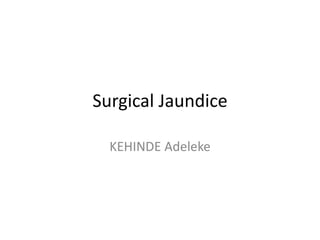This document discusses surgical jaundice, defined as jaundice that can be treated surgically, usually due to extrahepatic biliary obstruction. It covers the definition, causes, pathophysiology, clinical evaluation and treatment of surgical jaundice. The most common cause is gallstones, which can become lodged in the common bile duct. Physical examination may reveal jaundice and abdominal tenderness. Imaging studies can locate the obstruction and determine if it is intrahepatic or extrahepatic. Treatment involves addressing the underlying cause, often through surgery such as cholecystectomy for gallstones or bypass procedures for cancer.













































